|
|
Plastic/Metal Hybrid Technology | The name of this technology is taken from the Greek word "hybrid", which refers to the differing origin and properties of the materials.
The creation of a composite piece made of plastic and metal parts with mechanical locking between the two components, produced through injection molding or extrusion, enables production of highly load-resistant and low-cost parts.
In comparison to conventional injection molding, complex structures and performance that plastic alone has been incapable of producing can be created with plastic/metal hybrid technology.

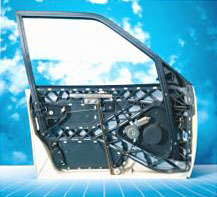 | | Fig. 1 Inside of a car produced through hybrid technology | Strengths - Complex structures with a high load capacity are feasible
- Reduction in component weight in relation to steel variant
- High integration potential
- Reduced storage costs
- Investment volume drops with increasing integration
- High degree of automation
- No finishing work
- Little warpage
- Corrosion-resistant
- Good damping behavior
- Easy to recycle

Although plastics already represent the state of the art in many applications, the use of plastics in load-bearing structures has been low to date for mechanical and safety-related reasons. And, with the progressive reduction in weight of metal structures, reductions in strength became increasingly apparent. A rise in failure due to dents was identified at nodal points and force transmission points as sheet metal became thinner and thinner. The deformation that occurs under load in this manner prevents full utilization of the load capacity of metal components. With relatively little effort, however, metal structures can be kept in their proper shape even under load. With the help of injection molding technology, plastic ribbing and bracing are molded onto the metal parts or metal profiles. These plastic structures enhance the capacity of the metal construction through optimal transmission and distribution of the forces in the component.
In the case of hybrid technology, the properties of two materials are combined in an optimal manner, resulting in synergistic effects that cannot be achieved with the respective materials alone.
Steel provides the following advantages:

- higher modulus of elasticity
- ductile behavior during failure
- simple, relatively flat deep-drawn parts, also easy to produce with punching
- tried and tested for many years in automobile production

The advantages of plastics, by contrast, are:

- complex design
- outstanding integration capability
- weight advantage over steel sheet
- corrosion-resistant
- molded-in color

In-depth studies have shown that composite plastic/metal designs can have a higher load capacity than open or even closed metal sections. With optimized ribbing the hybrid solution is similar to a closed metal solution, even under torsional load.
The technology is applied in practice in the Audi A6 AVANT and in the Ford FOCUS. Use of the technology in Audi vehicles led to a 10% reduction in production costs and a 15% reduction in weight. After initial experience with hybrid technology Audi is implementing this technology successively in other models.
In the case of the Ford Focus, a new step has been taken towards implementation of hybrid technology through consistent integration of functions into the component. In addition to narrow tolerances, the new insurance requirements were able to be met for this component through integration of the hood lock into the front end.

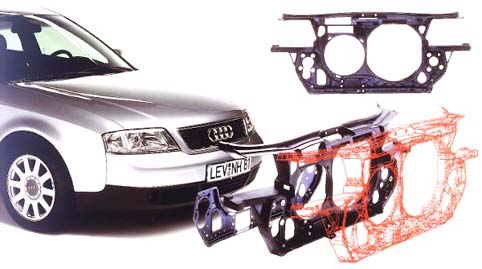 | | Fig 2. Front end A6 | Materials Of course, the combination of the two classes of material has to be taken into account in the selection of materials. Because of the mechanical linking of metal and plastic, materials with good relaxation characteristics should be used. From the group of semi-crystalline materials, polyamides are particularly suitable in this connection.
Optimal component behavior over a broad temperature range can be achieved by using the extensive family of Durethan polyamides, including impact-modified and glass-reinforced grades. Since the two materials are mechanically linked to each other during the injection molding process, the components produced in this way can be separated without any problems. The metal-plastic bond is eliminated in a hammer mill, and the materials are then separated from each other through magnetic separation.

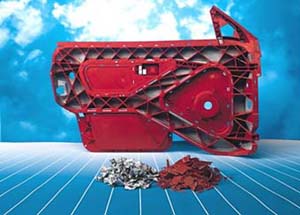 | | Fig. 3 Separation of metal and plastic in a hybrid door | 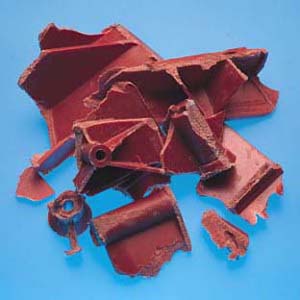 | | Fig. 4 Plastic after separation of a hybrid door with a hammer crusher | Component Design The degrees of freedom in the design of the plastic structure permit optimal component design. This means that a good distribution of forces is ensured in the component and stress peaks are avoided. To make sure that a durable bond can be maintained between metal and plastic even under high dynamic load, the stress distribution in the component is calculated and the plastic structure is adapted to the load case. The mechanical anchoring between metal and plastic now enables a large number of variations, including in-mold-assembly of the sheet metal components.

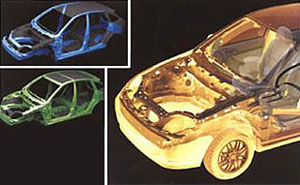 | | Fig. 5 CAE simulation: Over 100 virtual crash tests have been carried out with the Focus within the framework of its development. | Processing The primary production process is based on two widespread processing technologies, the plastic injection molding technique and the metal forming technique. After simple shaping of the sheet metal, the stamping is inserted in the mold and after the mold is closed, plastic is injection molded around it. After cooling the finished molding is removed from the machine. The production process can, of course, be automated and enables the manufacture of components of high quality on an industrial scale. Plastic/metal hybrid technology is also adaptable to vacuum forming, blow molding and extrusion processes.

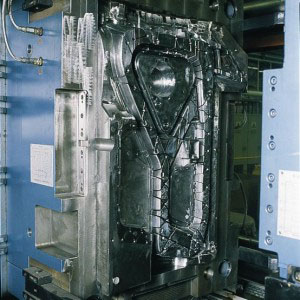 | | Fig. 6 Open mold | 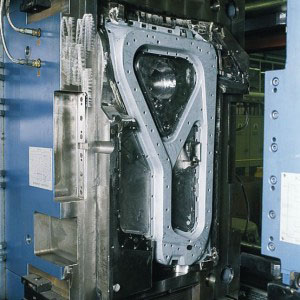 | | Fig. 7 Positioned metal part |  | | Fig. 8 Finished injection molded component | Molds Conventional injection molds are used in the production of hybrid components. The only special requirement for this process is the form-fit positioning of the metal insert in the injection mold. To produce high-quality components, it is necessary to match the injection mold precisely to the dimensions of the metal insert. However, this is possible without any significant additional expenditure by means of the present-day CNC-aided tooling production method. The mechanical connection can be implemented with minimal to no flashing, depending on processing and tooling variables.

Auxiliary Machinery In contrast to the conventional injection molding process, a large-area sheet metal part must be inserted in the case of the hybrid technology. Despite this additional operation, a fully automated process is possible provided that appropriate robotic handling units are available for insertion of the metal parts and later removal of the hybrid component.


| Related Information | | _Plastic/Metal Hybrid Technology - Innovative Solutions (667 KB pdf) |

| |
 |
|
|
|
|